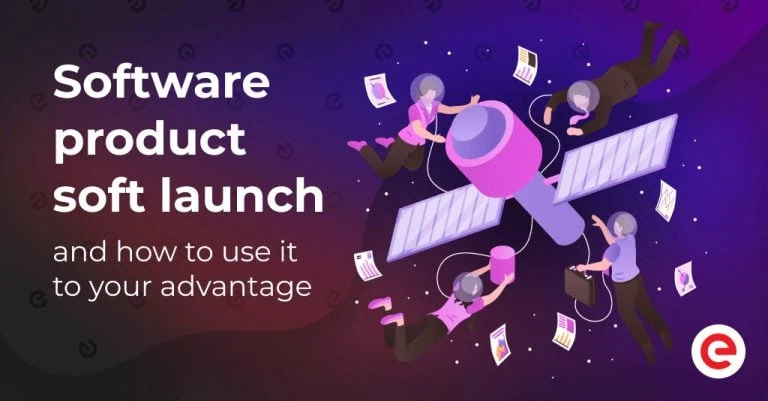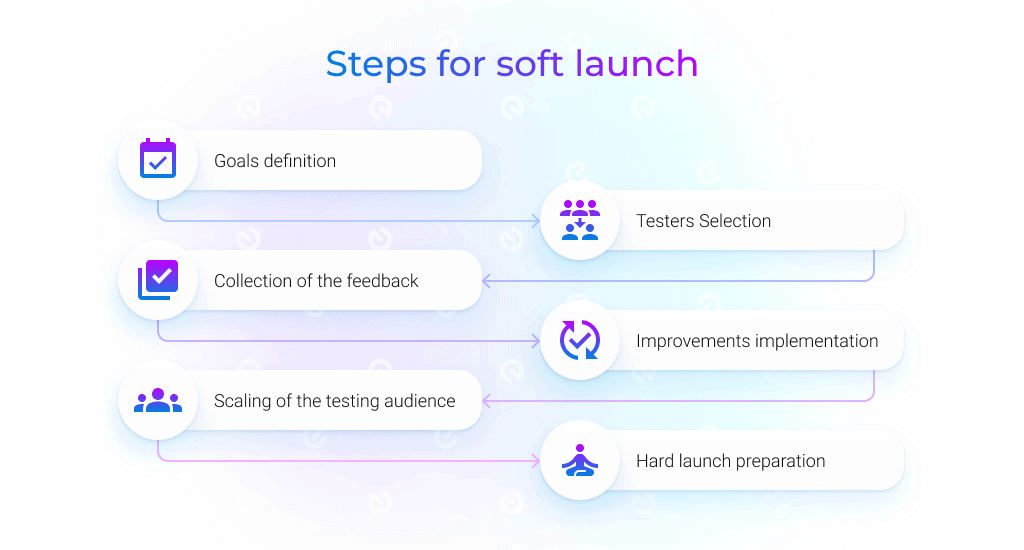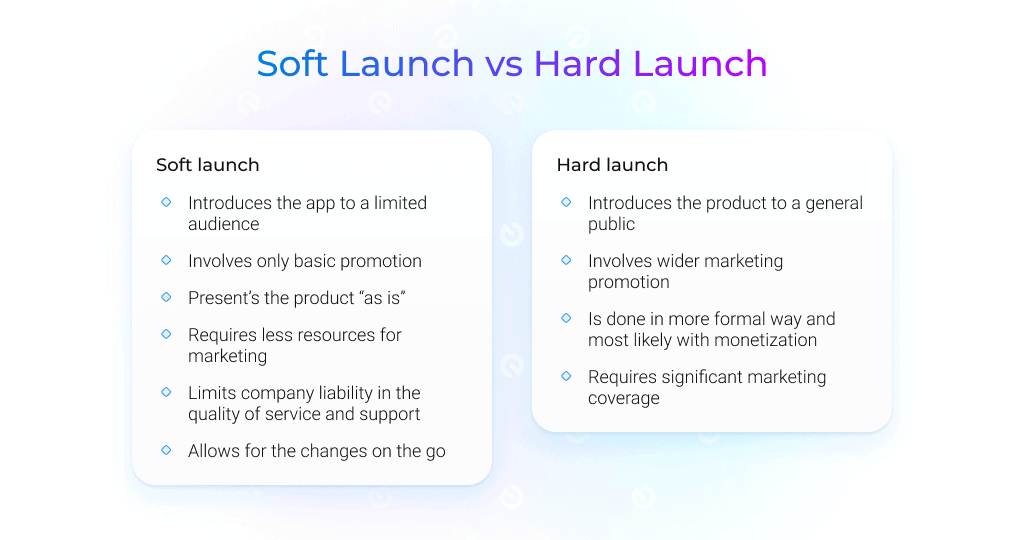
Updated: July 4, 2024
Published: January 10, 2023
Soft launching can be a useful way to build anticipation and create buzz for the full launch. By allowing select users to try out the product or service before it is widely available, companies can generate word-of-mouth marketing and build a loyal customer base in advance. In this article, we’re going to define soft launching, how it helps businesses to mitigate the risks with new products or features, and how it is different from hard launching of new applications.
List of the Content
- Definition of soft launching
- Steps for soft launching
- Examples of successful soft launches
- Soft launch vs hard launch
- Conclusion
DEFINITION OF SOFT LAUNCHING AND WHY IT CAN BE USEFUL
A soft launch is a way for companies to test and refine their products or services before a full launch. It involves introducing the product or service to a limited group of people in a low-key way, often through invitation-only or private beta testing.
The purpose of a soft launch is to gather feedback and identify any issues with the product or service before it is made widely available to the public. This allows companies to make improvements and fine-tune their offering, increasing the chances of success upon full launch.
There are several reasons why software development companies might choose to soft launch their products or services.
Feedback
One reason is to gather feedback and identify issues with the software before it is made widely available to the public. This is especially important in the software industry, where users have high expectations for reliability and performance. By gathering feedback from a small group of users during a soft launch, companies can identify bugs or other issues and fix them before the full launch.
Performance and scalability testing
Another reason for soft launching in software development is to test the scalability of the product or service. With a limited number of users during a soft launch, companies can see how their software performs under real-world conditions and make any necessary adjustments to ensure that it can handle a larger user base.
User behavior tests
Soft launching can also help companies gather data on user behavior and usage patterns. By observing how users interact with the software during a soft launch, companies can gather valuable insights into how people are using the product and make any necessary changes to improve the user experience.
A/B testing
Another advantage of soft launching in software development is allowing companies to test different software versions with different groups of users. This can be especially useful for companies that are developing software for different platforms or markets, as it allows them to see how the software performs with different user bases and make any necessary adjustments.
Resources management
In addition, soft launching can help companies manage their resources more effectively. By initially introducing the software to a limited group of users, companies can focus their efforts on gathering feedback and making improvements before a full launch rather than trying to address issues and fix bugs after the software has already been released to a wider audience.
Target audience validation
One important thing to consider when soft launching software is the selection of testers. It is important to choose a diverse group of testers that represents the intended user base of the software, as this will provide a more accurate representation of how the software will perform in the real world.
STEPS FOR SOFT LAUNCHING
Even compared to the hard launch – soft launching new software is still a big effort. Surely, the product team can focus on some of the insights it can bring to the table. But when done with proper KPIs and measurements – soft launching can give you a 360 view of what to expect from the full application launch for the months and years to come.
Another important is to see how the actual users are flowing through the app. Surely enough, your business analysts and product managers have written all the acceptance criteria for the app in advance. Needless to say, real-life user behavior might be significantly different from what’s expected.
How to write and test acceptance criteria?
Check our article, learn tips and tricks, and get the template that will ease your documentation writing.
If you are planning a soft launch for your software product or service, there are several steps you should follow to ensure a successful launch.
Goals definition
Before you begin the soft launch process, it is important to define your goals and objectives. What do you hope to achieve with the soft launch? Are you looking to gather feedback and identify issues, test scalability, or gather data on user behavior? Clearly defining your goals will help guide your decisions throughout the soft launch process.
Testers Selection
Choosing the right group of testers is crucial for a successful soft launch. It is important to choose a diverse group of testers that represents the intended user base of the software, as this will provide a more accurate representation of how the software will perform in the real world. You may also want to consider selecting influential testers in your target market, as they can help generate buzz and anticipation for the full launch.
Collection of the feedback
During the soft launch, it is important to gather as much feedback as possible from your testers. This can be done through surveys, focus groups, or one-on-one interviews. Make sure to listen to the feedback you receive and use it to make improvements to the software.
Improvements implementation
Based on the feedback you receive during the soft launch, it is important to make necessary improvements to the software. This could include fixing bugs, optimizing performance, or adding new features.
Scaling of the testing audience
Once you have gathered feedback and made improvements, you can gradually expand the soft launch to include more testers. This will allow you to gather even more feedback and continue refining the software before the full launch.
Hard launch preparation
As you near the end of the soft launch period, it is important to start preparing for the full launch. This could include finalizing marketing materials, building buzz and anticipation, and making any final adjustments to the software.
Overall, the steps for soft launching in software development involve defining your goals, selecting testers, gathering feedback, making improvements, gradually expanding the launch, and preparing for the full launch. By following these steps, you can ensure that your software is as reliable and user-friendly as possible before the full launch.
Want to make an app that retains your users with robustness and cool UI/UX?
Existek is a professional software development company with a 10 years successful track record of web and mobile apps development. Contact us and get a free consultation on how is best to approach your project.
EXAMPLES OF SUCCESSFUL SOFT LAUNCHES
There are many examples of successful soft launches in the software industry. Here are a few notable examples:
Google Maps
Before its full launch in 2005, Google Maps underwent a soft launch as a tool for developers. This allowed the company to gather feedback and make improvements to the software before it was made widely available to the public. Today, Google Maps is one of the world’s most widely used mapping services.
Dropbox
Dropbox underwent a soft launch in 2007 when it was made available to a small group of users through invitation-only beta testing. This allowed the company to gather feedback and make improvements to the software before its full launch in 2008. Today, Dropbox is a widely used file storage and sharing service with over 500 million users.
WhatsApp underwent a soft launch in 2009 when it was made available to a small group of users through invitation-only beta testing. This allowed the company to gather feedback and make improvements to the software before its full launch in 2010. Today, WhatsApp is among the most, if not the most, popular messaging apps worldwide, with over 2 billion users. As proof of how effective the soft launching appears to be for WhatsApp, we can mention that the company conducted a number of tests for other products, such as WhatsApp for business introduction in India in 2017.
Slack
Slack underwent a soft launch in 2013 when it was made available to a small group of users through invitation-only beta testing. This allowed the company to gather feedback and make improvements to the software before its full launch in 2014. Today, Slack is a widely used collaboration and communication platform with over 100 million daily active users.
Pokémon Go
Pokémon Go underwent a soft launch in 2016 when it was made available in select countries through invitation-only beta testing. This allowed the company to gather feedback and make improvements to the software before its full launch in July 2016. The game became an instant hit, with millions of users downloading it within the first few days of its release.
Signal
Signal underwent a soft launch in 2014 when it was made available to a small group of users through invitation-only beta testing.
Since its full launch in 2015, Signal has become one of the most popular messaging apps in the world, known for its strong focus on privacy and security. The company’s decision to soft launch the product allowed them to gather feedback and fine-tune the software before it was made widely available, contributing to its success.
Overall, these examples demonstrate the effectiveness of soft launching in the software industry. By introducing their products or services to a limited group of users and gathering feedback, these companies could fine-tune their software and ensure a successful full launch.
SOFT LAUNCH VS HARD LAUNCH AND HOW TO CHOOSE THE MOST SUITABLE OPTION
On the opposite, a hard launch is when a product or service is introduced to the market in a more formal and widespread way. Hard launches tend to involve more marketing and promotion, and the product or service is made available to a larger audience from the outset. The goal of a hard launch is to maximize exposure and reach as many potential customers as possible from the start.
Also, one of the very important advantages of a soft launch is that it can be conducted without the monetization strategy, which can be defined later on based on the users’ behavior. Additionally, it limits company liability since the soft launching of the application means providing it “as is” even if monetization is there.
Want to know more about the monetization strategies for a modern mobile application?
Check for more details in the article on the ways to make money with your application.
Here is a comparison of the hard launch and soft launch in the software development industry:
Hard launch:
- Introduces a product or service to the market in a more formal and widespread way
- Involves more marketing and promotion
- Makes the product or service available to a larger audience from the outset
- The goal is to maximize exposure and reach as many potential customers as possible from the start
- May require more resources in terms of marketing and promotion
Soft launch:
- Introduces a product or service to the market in a limited, low-key way before a full launch
- Often done through invitation-only or private beta testing, where a small group of users is given access to the product or service to try it out and provide feedback
- The purpose is to gather feedback and identify any issues with the product or service before it is made widely available to the public
- Allows the company to make improvements and fine-tune its offering before a full launch
- Can be a useful way to build anticipation and create buzz for the full launch
- Can be a more resource-efficient approach, as it allows the company to focus its efforts on gathering feedback and making improvements before a full launch
So which approach is best for a software development company? The decision to go with a soft launch or a hard one depends on the company’s specific goals and needs. Here are some factors to consider:
Maturity of the product or service
If the product or service is still in the early stages of development and may require significant changes based on feedback, a soft launch may be the better choice. This will allow the company to gather feedback and make improvements before a full launch. On the other hand, if the product or service is fully developed and ready for widespread use, a hard launch may be more appropriate.
Target market
If the target market for the product or service is small and specialized, a soft launch may be the better choice. This will allow the company to gather feedback and build anticipation within a specific community before a full launch. A hard launch may be more appropriate if the target market is larger and more diverse.
Competition
If the market is crowded with similar products or services, a soft launch may be a good way to differentiate the product and build anticipation before a full launch. On the other hand, if the market is less competitive, a hard launch may be more effective at maximizing exposure and reach.
Resources
A soft launch can be a more resource-efficient approach, as it allows the company to focus its efforts on gathering feedback and making improvements before a full launch. A hard launch, on the other hand, may require more resources in terms of marketing and promotion.
CONCLUSION
While soft launching has many advantages, it is important to remember that it is not a replacement for thorough testing and quality assurance. Software should still be thoroughly tested and refined before a full launch, even if it has undergone a soft launch.
Ultimately, the decision to go with a soft launch or a hard launch will depend on the specific goals and needs of the company. By considering factors such as the maturity of the product or service, the target market, competition, and available resources, companies can determine the best approach for launching their software.
Looking for some additional assistance with launching your products?
Existek’s team is glad to answer your questions and assist with delivering custom software solutions. We’re ready to share our extensive experience and help with a successful product launch to withstand the market competition.
Frequently asked questions
What is soft launching?
The soft launch is one of the efficient ways of testing and refining software products before the actual launch. It focuses on introducing developing solutions to a limited user group to gather valuable insights and identify possible issues.
What does soft launching mean for businesses?
The soft launch has brought a number of advantages for businesses, including feedback, A/B testing, resources management, performance and scalability testing, user behavior tests, and target audience validation.
How to develop the soft launch strategy?
In order to ensure a successful launch of your software products, the teams have to follow several steps:
Define the goals
Select the testers
Collect the feedback
Improve implementation
Scale the testing audience
Prepare the hard launch
What are examples of successful soft launching?
Looking through the excellent market practices, we can mention the following examples:
Google Maps
Slack
Dropbox
Pokémon Go
Signal




